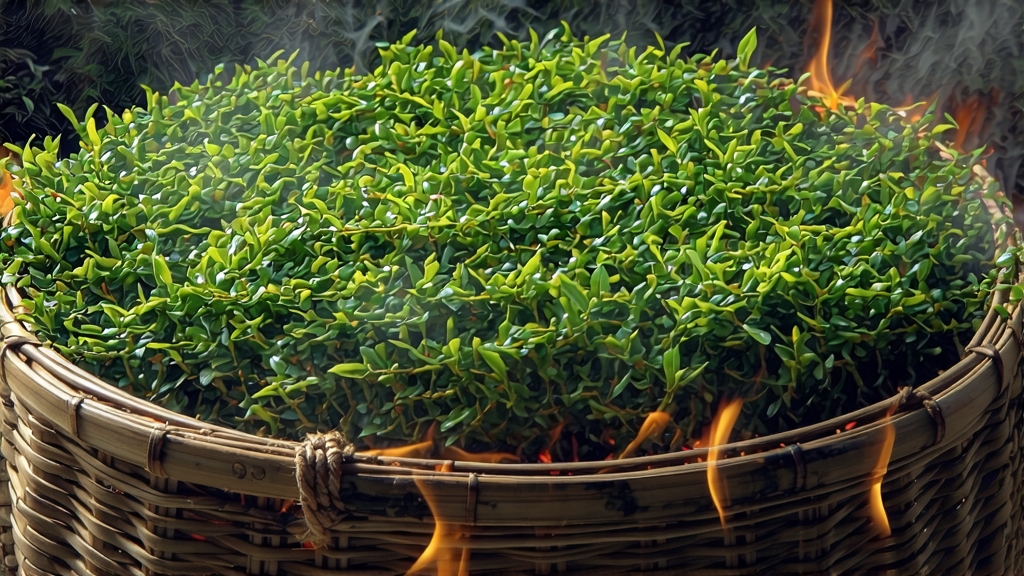
Long before Assam, Ceylon or Earl Grey ever reached a London cup, the first fully oxidised black tea in history was born in the rugged Wuyi Mountains of northern Fujian. Locals call it Zheng Shan Xiao Zhong—“small leaf from the original mountain”—but the outside world knows it as Lapsang Souchong, the tea that taught Europe what “black” could taste like. This is the story of how a Qing-dynasty accident of war, pine and fire became the prototype for every black tea on earth, and how, four centuries later, it is still hand-made in the same stone hamlets, drunk in the same porcelain cups, and whispered about in the same breath as Burgundy or Islay malt.
-
Terroir: the canyon that breathes tea
The Wuyi Biosphere Reserve is a UNESCO site of towering cliffs, running mist and mineral-rich laterite soil. At 27° north latitude, day-night temperature swings of 15 °C force the tea bush (Camellia sinensis var. sinensis, “Xiao Ye Zhong” cultivar) to grow slowly, thickening cell walls and concentrating aromatic oils. The canyon’s ever-present pine and cedar release resin into the air; their roots share mycorrhizal fungi with the tea gardens, a living terroir that later translates into the tea’s signature resinous sweetness. Only leaves picked within the 60 km² core zone around Tongmu Guan village may legally be sold as Zheng Shan Xiao Zhong; everything else is simply “smoked black tea.” -
A history written in gunpowder and trade winds
The year is 1646. Qing troops sweep through Fujian; troop movements interrupt the late spring tea harvest. Farmers, desperate to dry their leaves before they rotted, speed-fired them over fresh pine logs in the drying room. The smoke penetrated the leaf; the colour turned ebony; the flavour was strange, tarry, unforgettable. Dutch traders at the port of Xiamen tasted it, bought every basket, and shipped it to Amsterdam and then London where it was christened “Bohea” (from the local Min-dialect name for Wuyi). By 1669 the British East India Company listed “Souchon” (a corruption of Xiao Zhong) as its most expensive tea, priced higher than silver. Thus Lapsang Souchong became the template for every subsequent black tea: wither, roll, oxidise, dry—four steps that revolutionised world tea craft. -
Two families, two styles
Today Tongmu Guan is still only 200 households, split largely between the Xiong and the Jiang clans. Each guards a slightly different recipe.
Traditional Pine-Smoked Lapsang
- Withering: fresh leaves are laid on bamboo screens suspended over dying embers of local Masson pine and cedar for 8–10 hours; the smoke is cool, never above 35 °C, so the leaf does not cook but absorbs volatiles such as guaiacol and syringol.
- Rolling: done by hand on rattans trays for 45 minutes to rupture cells and start oxidation.
- Oxidation: the leaf is piled in pine-wood boxes, covered with wet cloths, and left for 4–5 hours at 26 °C, 85 % RH, turning every 30 minutes. The leaf turns from jade to copper to dark chocolate.
- Smoking & Drying: the final firing uses pine branches rich in resin; the leaves are passed three times through a 90 °C oven, each pass lasting 20 minutes. Total smoking time is 2–3 hours, but the memory of the pine will last decades.
Unsmoked “Zheng Shan Xiao Zhong” (Original Mountain Version)
In 2005 a Tongmu master named Jiang Yuanxun experimented with drying the leaf over longan-wood charcoal instead of pine. The result is a tea that keeps the Wuyi minerality and longan sweetness but loses the campfire note. It is now prized in China’s domestic gongfu scene and is often called “the Burgundy of black teas” for its red-fruit, honey and wet-stone complexity.
- Craft signs: how to recognise authenticity
Look for tight, glossy strips the colour of midnight pine bark; they should smell of pine resin, not